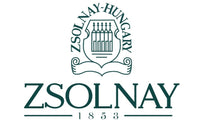Zsolnay's Impact
Hungarian Architecture
In 1886 the Zsolnay Manufacture introduced a frost-resisting building material called Pyrogranit. This new and innovative material was quickly picked up by some of Hungary's most influential architects such as Ödön Lechner and Miklós Ybl.
Pyrogranit allowed the creation of fine and detailed ornaments which could be used on the facades of buildings. These ornamental ceramics were extremely popular during the Art Nouveau movement which had a strong hold on European architecture at the time. Several Hungarian landmark buildings, including the Parliament building and the Museum of Applied Arts, demonstrate the exceptional achievements of the Zsolnay factory in the production of architectural ceramics.


Landmark of Budapest
The Matthias Church
Hungarian architect Frigyes Schulek was the man in charge of rebuilding the Matthias Church. As part of these renovations, the Zsolnay manufacture in Pécs was commissioned to supply nearly 150,000 roof tiles which are to this day a distinctive splash of color in the Budapest Castle District. The beautiful tile pattern is a must-see for all Budapest visitors.
Zsolnay architectural ceramics were widely used and became dominant on public buildings in Budapest and across other European cities, mostly at the turn of the century. Zsolnay's decorative ceramics also represent a tribute to the splendid architects, painters and sculptors of the time that recognized a unique opportunity in these exquisite materials.
Green & Yellow
Museum of Applied Arts
Ödön Lechner, one of Hungary's most influential architects, designed and built the Museum of Applied Arts in the years between 1893 and 1896. His distinctive Hungarian Szecesszió style, which was related to Art Nouveau, makes this building one of many Budapest monuments.The distinctive green and yellow tiles on the roof were manufactured by the Zsolnay factory in Pécs.
Beautifully formed decorative elements can be found in the entrance lobby and the roof of this magnificent palace-like building.


Heart of Hungary
The Hungarian Parliament
Vilmos Zsolnay and Imre Steindl, the architect who designed the Parliament building, had a close relationship. Steindl was convinced that pyrogranit elements would enhance the artistic design of the historically important building.
The 'Lounge of the Chamber of Peers' is adorned with 88 statues evoking old Hungarian ethnic groups and trades made by the Zsolnay manufacture. Each of these statues is made from the durable pyrogranit material invented by Zsolnay in 1886.
The Blue Wall
Dorothea Hotel Budapest
In the heart of Budapest, on Vörösmarty Square, you can find Budapest's new 5-Star Dorothea Hotel. Well-known Milanese architecture office Lissoni & Partners managed to fuse modern architecture with historical Hungarian architecture.
At the heart of the hotel lobby and courtyard is the wall of Zsolnay tiles that catches the eye immediately. The stunning blue Zsolnay wall made of hundreds of Pyrogranit tiles was exclusively created for the Dorothea Hotel. Each blue pyrogranit tile was handmade and glazed in a refreshing shade of blue.

